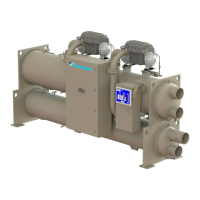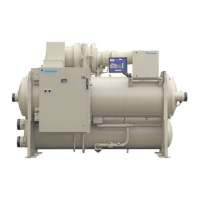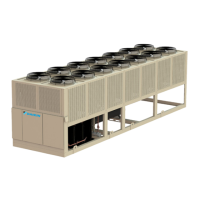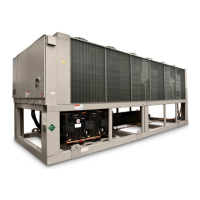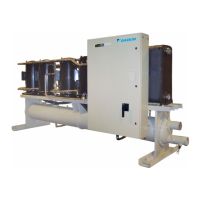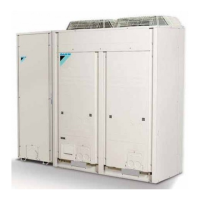ELECTRICAL
NAVIGATOR WWV/TWVDAIKIN APPLIED
20
Electrical
Power wiring connections to the chiller may be done with either
copper or aluminum wiring. Wire should be sized and installed
per NEC and/or local codes. Wire sizing and wire count must
t in the power connection lug sizing listed in chiller submittals.
All wiring within the unit is sized in accordance with the USA
National Electrical Code. Refer to the unit nameplate and the
submittals for the correct electrical ratings.
DANGER
Qualied, licensed electricians must perform wiring. Electrical
shock hazard exists that can cause severe injury or death.
The eld power wiring required varies depending on unit model.
See page 21 for wiring information. These wiring diagrams are
also provided with the chiller.
NOTICE
Wiring, fuse, and wire size must be in accordance with the
National Electric Code (NEC). The voltage to these units must
be within ±10% of nameplate voltage (415V units must have
voltage within -13% and +6% of nameplate voltage) and the
voltage unbalance between phases must not exceed 2%. Since
a 2% voltage unbalance will cause a current unbalance of 6 to
10 times the voltage unbalance per the NEMA MG-1 Standard,
it is most important that the unbalance between phases be kept
at a minimum.
CAUTION
Do not use power factor correction capacitors with WWV chillers.
Doing so can cause harmful electrical resonance in the system.
Correction capacitors are not necessary since VFDs inherently
maintain high power factors.
Control panels are rated for the amount of current that can
be passed through it and still contain the damage within the
enclosure; this value is known as the short circuit panel rating as
shown in Table 7 and is standard on all WWV and TWV models.
Table 7: Short Circuit Current Ratings (kAmps)
Voltage/Hz High Short Circuit Panel Rating
460/60
65kA380/60
400/50
575/60 25kA
Field-supplied disconnect switches are required if not factory-
supplied with the unit. Disconnecting means are addressed
by Article 440 of the U.S.A. National Electrical Code (NEC),
which requires “disconnecting means capable of disconnecting
air conditioning and refrigerating equipment including motor-
compressors, and controllers from the circuit feeder.” Select and
locate the disconnect switch per the NEC guidelines.
Control Circuit
The unit control circuit is powered at 120 Vac. Terminals are
provided in the unit control panel for optional eld hookup of the
control circuit to a separate fused 115-volt power supply in lieu of
the standard factory installed control transformer.
Water ow switch interlock terminals are included in the
controller. See Figure 16 for the correct connections in the eld.
The purpose of the water ow switch interlock is to prevent the
compressor from running while the evaporator and condenser
water pumps come online and provide the correct water ow.
It is best to leave pump control to the unit controller for better
system management. If an external system independently
manages pump starts, use the following guidelines:
• Turn on evaporator pump 2 minutes before enabling the
machine
• Turn o evaporator pump 5 minutes after disabling the
machine
Use with On-Site Generators
Switching from site grid power to generator power and vice
versa requires that the chiller must either be powered down or
the power must be o for more than 5 seconds to avoid sending
out of phase voltage to the chiller. A properly installed, fully
Synchronized Automatic Transfer Switch must be used to transfer
power if the chiller is running under load.
Generator Sizing
WARNING
Generator must be sized by an electrical engineer familiar with
generator applications.
Transfer Back to Grid Power
Proper transfer from stand-by generator power back to grid
power is essential to avoid chiller damage and must be used to
ensure proper function of the unit.
WARNING
Stop the chiller before transferring supply power from the
generator back to the utility power grid. Transferring power while
the chiller is running can cause severe chiller damage.
The necessary procedure for reconnecting power from the
generator back to the utility grid is as follows:
1. Set the generator to always run ve minutes longer than
the unit start-to-start timer, which can be set from two to
sixty minutes, while keeping the chiller powered by the
generator until the fully Synchronized Automatic Transfer
Switch properly hands over chiller power from the site.
2. Congure the transfer switch provided with the generator to
automatically shut down the chiller before transfer is made.
The automatic shut-o function can be accomplished
through a BAS interface or with “remote on/o” wiring
connection shown in Figure 16.
A start signal can be given anytime after the stop signal since the
three-minute start-to-start timer will be in eect.
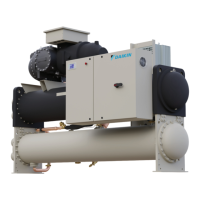
